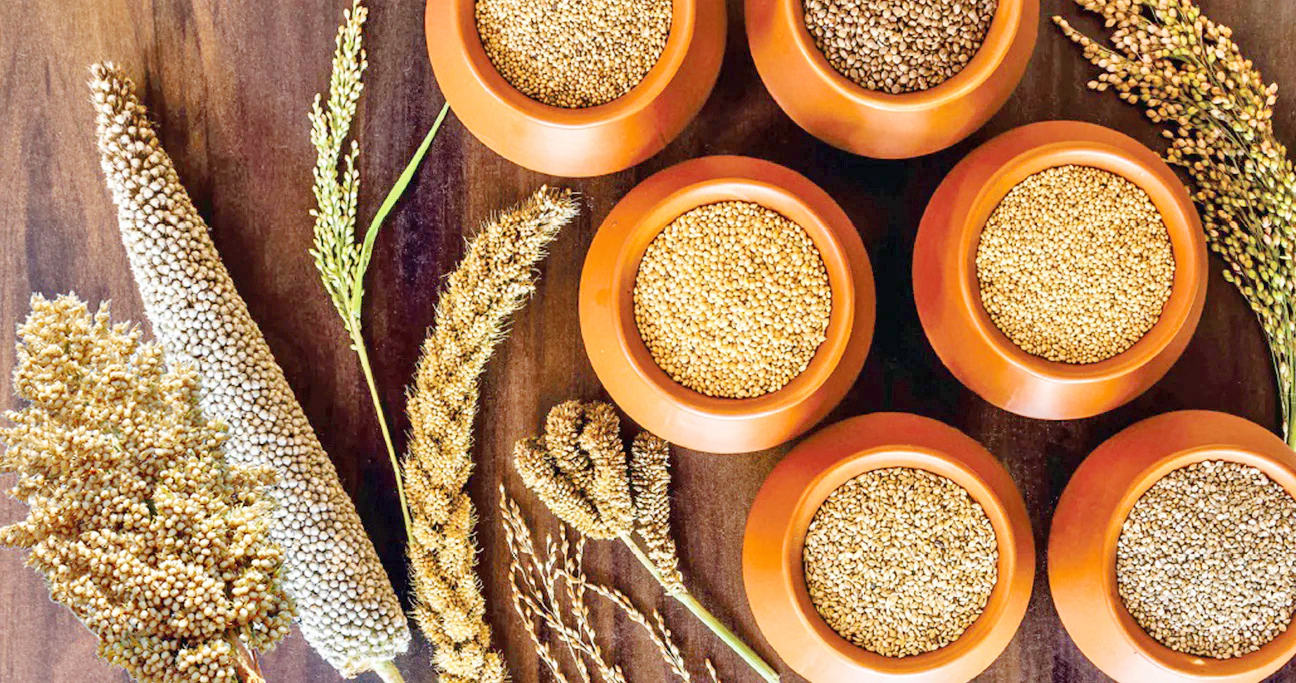
Rajasthan’s millet bounty has its own long story of plentiful supplies of rich harvest of millets. Millets today defined as a ‘super food’ has its roots in agricultural history of Rajasthan.
Different methods of farming have been invented with very little water. The farmers of Rajasthan have left their mark in the country, especially in the production of coarse grains. This is the reason why today Rajasthan ranks first in millet production in the country. It is also a pleasant coincidence that India grows the largest number of millets in the world, while the largest number of millets in India is cultivated in Rajasthan.
Rajasthan grows not only millet but also ragi and rapeseed.
Rajasthan is recognized as the largest millet growing state in the country. But it is very pleasant to know that not only millet is grown as coarse grain in the state but also Sawa, Kangni, Kodo and Kutki are produced. Although their quantity is very less, the farmers of the state have a centuries-old tradition of growing coarse grains. That is why farmers of the state grow coarse grains.
Rajasthan has the highest production of millet in the country.
Millet and jowar are the main coarse grains produced in the state. Apart from millet and jowar, in the areas of tribal dominated southern districts of Dungarpur, Banswara, Jalore and Sirohi of the state, among the coarse grains, Sanwa, Kangni, Kodo and Kutki are also produced.
1. Finger Millet (Ragi)
Finger Millet, popularly known as Ragi is commonly consumed by fitness enthusiasts as a healthier alternative to rice and/or wheat. It is a gluten-free variant of Millet, rich in proteins and amino acids. In growing children, finger millet is intended to facilitate brain growth. It is also high in calcium and has healthy concentrations of iron and other minerals as well. Ragi also has a good number of essential amino acids essential for the human body in the antioxidant activity of traditional Indian foods.
2. Foxtail Millet (Kakum/Kangni)
Foxtail Millet, also known as Kakum/Kangni in India, is usually available in Semolina or rice flour. It is rich in carbohydrates that helps in balancing blood sugar levels in the body. Foxtail Millet can improve overall immunity. Foxtail Millet is the closest to rice. It is most commonly used as a substitute for rice across the world.
3. Sorghum Millet (Jowar)
This is yet another popular type of Millet in India to make Rotis and other bread. It is locally known as Jowar. Organic jowar is a rich source of iron, protein, and fibre and, because of the presence of policosanols, can help lower cholesterol levels. People with wheat allergies can have Jowar as a healthier alternative. Jowar also has more antioxidants than blueberries and pomegranates and is rich in calories and macronutrients. Sorghum helps increase metabolism.
4. Pearl Millet (Bajra)
Pearl millet or Bajra is one of the most common types of millets that you must have tasted. It is prepared in various ways, including roti and khichdi, with immense health benefits. Bajra includes iron, fibre, protein, and minerals such as magnesium and calcium. It can be perfect for your well-being to practice regular pearl millet intake, such as helping you battle type II diabetes.
5. Buckwheat Millet (Kuttu)
Buckwheat, also known as Kuttu in India, is one of the most common types of Millet and is often used during the Navratra fasting time. It is diabetic-friendly and helps in reducing blood pressure. It is helpful for good cardiovascular health, and if you want to lose weight, it should be integrated into your diet. Buckwheat also protects against cancer of the breast, asthma in children, and gallstones.
6. Amaranth Millet (Rajgira/Ramdana/Chola)
You must have heard about the incredible benefits of Amarnath Oats. But do you know that Amarnath, also known as Rajgira, Ramdana, and Chola, is a types of Millets? This Millet is rich in protein and dietary fibre. It is great for a healthy diet. This Millet also helps in fighting greying and hair loss. Amaranth also lowers cholesterol levels and cardiovascular disease risk. Calcium, vitamins, and other minerals are high in it.
7. Little Millet (Moraiyo/Kutki/Shavan/Sama)
Little Millet is one of the major in list of millets, it is also called Moraiyo, Kutki, Shavan, and Sama. It is loaded with vitamin B and essential minerals such as Calcium, Iron, Zinc, and Potassium. Little Millet is largely used in Southern states of India in numerous traditional dishes. It is a healthier alternative to rice and does not cause weight gain.
8. Barnyard Millet
Barnyard Millet is popular in millets name list and also known as Sanwa. It is stacked with high amounts of dietary fibres that help improve bowel movement and aiding weight loss. It is rich in calcium and phosphorus, which can strengthen bone density.
9. Broomcorn Millet
Popularly known as Chena in India, Broomcorn helps balance blood sugar leve ls as it has a low glycemic index. It is a good option for diabetics to be incorporated into a daily diet. Switching to a diet with Millet can be a good transformation as far as nutrition is concerned.
10. Kodo Millet
Kodo Millet, also known as Kodon Millet, is a digestible variant with higher amounts of lecithin amino acid. It has a significant effect on strengthening the nervous system. Kodo is a fantastic source of B vitamins, especially niacin, B6, and folic acid, among other vitamins and minerals. It contains calcium, iron, potassium, magnesium, and zinc minerals. Being a gluten-free millet, it is great for gluten- intolerant individuals. It can relieve cardiovascular disorders such as high blood pressure and cholesterol levels when eaten regularly by postmenopausal women.















